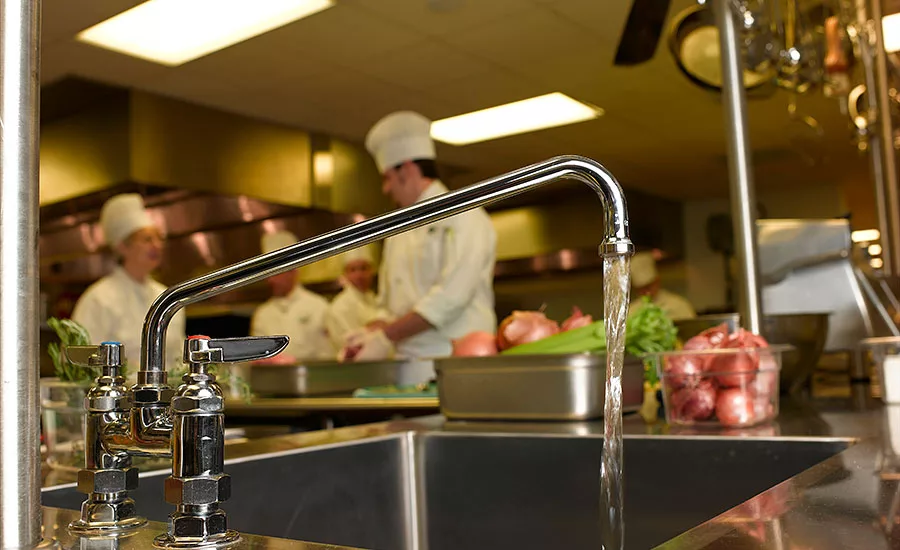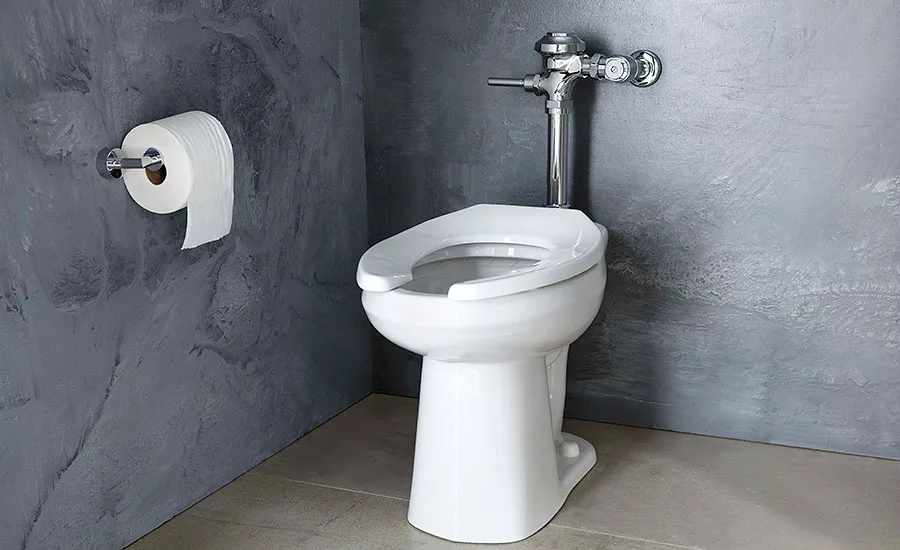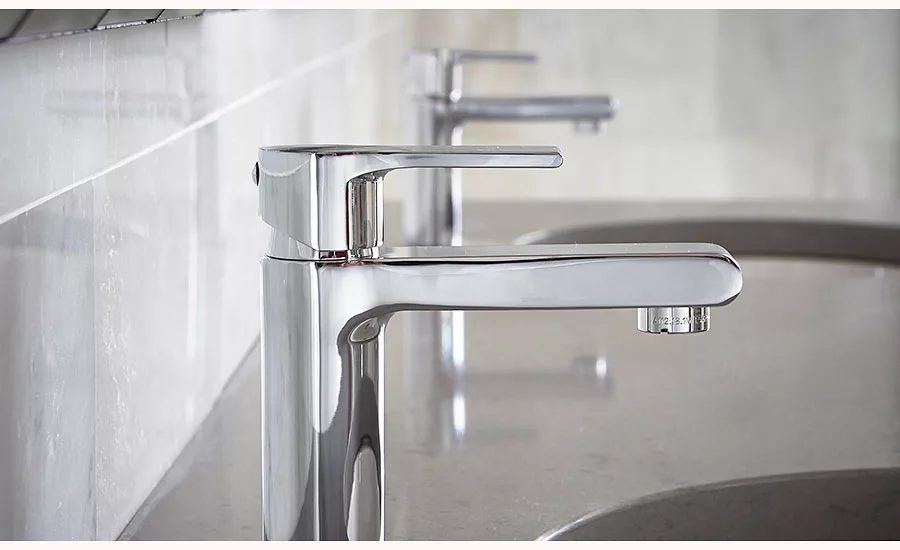Vive La Difference: Commercial vs. residential plumbing products – why the distinction?

The subtle differences between commercial and residential products help commercial items survive in harsher environments. T&S Brass photo.

Commercial toilets need to accommodate a wider array of users (and habits) than your typical residential unit. Gerber photo. While many commercial faucets have all-metal internals and bodies, many residential faucets feature lightweight plastic components inside a metal shell. Danze Photo.

Waiting patiently in the restroom line at a baseball stadium recently, I was probably the only one pondering what goes into designing the rows of toilets and faucets ranked along walls. There was the usual commentary about there never being enough stalls for the crowd, but that’s another story.
The point is commercial bathrooms and kitchens do present some different challenges from residential. “Commercial products are based on functionality, durability, water conservation and simple, clean design intended for high volume traffic,” says Eric Moore, senior interior designer, Kohler. “Residential products come in all styles of design — traditional, transitional and contemporary — as well as a plethora of sizes and installation options for the consumer to create a space around.”
If the building is a revolving door for visitors, like a school, stadium or short-term medical care facility, it’s important to install commercial-grade products that can withstand heavy use, and even occasional misuse, from unfamiliar users, says Lisa Shimko, associate product manager, Moen. “In a residential setting, individuals are more likely to take ownership of their space and treat it with respect. Commercial facilities need plumbing products that are going to last, with minimal upkeep and repair. Commercial faucets are built using heavy-duty materials and have vandal-resistant features. Our products are thoughtfully designed to solve common maintenance issues and can help deliver a lower total cost of ownership.”
Basically, it does all come down to overall durability and ruggedness of the product, says Jeff Baldwin, design engineering manager, T&S Brass. “In a residence, you’re not using the product as much and there is a lot less vandalism. In the bathroom at your house, you may wash your hands 10 times a day. In a commercial application — in a public bathroom at an airport, restaurant, school or hospital setting — that product is being used tremendously more than a residential product. In a public restroom, users can be varied. You could have anyone from a five-year-old to a 100-year-old using your product. You also have to ensure that your product meets ADA standards.”
Both commercial and residential toilets try to accomplish the same task, says Paul Conrad, vice president of innovation in polymers, Mansfield Plumbing Products. “They try to take away human waste and take them to a delivery system within a building; but the way that they do that is different and it’s usually centered around usage and construction. Construction for commercial buildings is often designed differently than residential buildings.
“In commercial, you’ll have a row of stalls and sometimes a bathroom one floor above another floor, residential not so much,” Conrad explains. “With the fixtures themselves, commercial products tend to be designed for very utilitarian-type purposes. I mean, they serve that specific purpose and then in residential, there could be a little more style involved, whether somebody wants to be transitional, traditional, whatever style they prefer.”
“The primary differences between commercial and residential toilets and sinks revolve around how they address the following factors: number of users, presence of industrial grade piping and higher water pressures,” says Lovin Saini, senior product manager, Gerber Plumbing Fixtures. “Commercial applications must accommodate a greater number and higher frequency of daily users than residential toilets. For example, the typical household averages five flushes/day in a residential toilet, whereas a gas station bathroom may be five per hour, or a public multi-user bathroom facility like an airport may be five flushes every few minutes. Based on these types of needs, a commercial toilet will be built to a heavier duty standard and designed to last 10-20 years.
“Piping will need to be constructed and developed in such a way that the bathroom doesn’t shut down due to clogging, low water pressure, poor hygiene or unnecessary costs to install or maintain,” Saini says. “Finally, in addition to flushing needs and water pressures, safe and appropriate usage of the toilets is key. In prior examples, the specifier may specify a bathroom layout to assist wheelchair users or those w/ physical limitations under the ADA code; however, personal safety must be maintained as well.”
“In most cases, residential applications will have a more ‘controlled’ environment,” says Chris Peterson, regional sales manager, Saniflo. “That is, what goes down the toilet is usually more manageable because there are fewer users than in a public facility. In high-demand or commercial applications, items such as feminine products and baby wipes are more likely to be flushed down the toilet.
“Because of these more rigorous demands, Saniflo sells a heavy-duty macerating blade that incorporates a grinder. A grinding macerator, such as the Sanibest Pro, is capable of handling items you might want to avoid flushing when using the standard macerating system. Grinders also use larger horsepower motors to help push the waste further distances.”
Commercial = Heavy-duty?
“The overall key in commercial settings is to use durable, low-maintenance and easy-to-clean products to avoid costly repairs and potentially limiting the service of the facility,” says Katie Hayes, senior product manager, Danze and Gerber. “Many times people think that commercial products should be more heavy-duty, but that doesn’t always have to be the case. For Danze, many of our residential faucets can withstand certain commercial settings without issue. The components we use within the faucets — solid brass construction, resistant-free hoses and ceramic disc valves — are already at the top of the durability and quality spectrum when it comes to faucet construction.”
Gerber commercial faucet products are designed to withstand prolonged, less considerate usage, Hayes says. “Often times, commercial products are more utilitarian in design, and less focused on style; products like metering bath faucets, and wall-mounted utility and laundry sink faucets are focused on function. Durability, low-maintenance and ease-of-cleaning are key features in commercial applications.
“Products specific to commercial applications are sometimes a heavier weight and have tamper-proof handles and aerators to minimize potential for vandalism. The Danze product offering blurs the lines between commercial and residential; providing high quality and durability with trend-relevant styles, which is a perfect combination for style-conscious applications like restaurant restrooms and hospitality areas.”
“Vandalism is a huge concern when you are talking about public, commercial-type environments,” Baldwin says. “You have to have a rugged product. We tend to stick with metallics. In a commercial setting, you normally see metallics in a brass faucet. There’s a drastic difference when you cross over to the residential design of faucets. A lot of them are non-metallic [plastic] underneath with a metal shell, so it is not designed to take a lot of impact.
“We have to be a lot more stringent with our plating of fixtures because of heavy usage. If you go into a school or hospital environment, those products are seeing a lot more cleaning chemicals, a lot more abrasives, than in your normal residential setting.”
There’s a slight distinction between light commercial faucets used in an office building, for example, and faucets used in an airport, school or hospital, Baldwin says. “Most manufacturers use the same platform or same designs for heavy duty commercial versus light duty commercial. The distinction is usually aesthetics. It may have the same chassis underneath, but there may be a different body that blends with the look they are trying to get in their kitchen or bathroom — more curves, more appeal, more contours, sleek lines, a more aesthetically pleasing look.”
When products cross-over
Are commercial products suitable to retrofit into a residential setting if someone wants a “step up” or if someone just likes the industrial look?
“While there are many ‘crossover’ American Standard products, such as our new VorMax toilets and new wall-hung Decorum sinks that can be used for both commercial and residential applications, commercial fixtures often have unique features and benefits that are not required for residential applications,” says Jim Reinhart, senior product manager for the trade market, residential and commercial fixtures, American Standard. “For example, most commercial toilet bowls are flushometer-based products that can handle frequent and automatic flushes in a short period of time.
“Also, with the exception of a few man caves, urinals are still primarily found in commercial applications only. Commercial fixtures are also often attached to the wall with robust carrier systems to provide necessary ADA compliant clearances, increased load capabilities, and overall cleanability access that do not apply in a typical residential application.”
There’s no reason why a Moen Commercial product couldn’t be retrofitted for someone to use in their home, if they so desired, Shimko says. “Since our products are built and tested to withstand busy commercial environments, they could withstand residential use — no problem. When it comes to style, designers and homeowners will have more options with residential products.
“Commercial products are designed specifically to offer high-traffic facilities with plumbing solutions that will enhance the space, and provide durability and accessibility for years to come,” Shimko adds. “While some homeowners might request commercial products for their space, taking the reverse approach in high-traffic commercial spaces is not the best long-term decision if you’re looking for longevity, reliability and durability.
“Moen does offer new product options from the residential side that can help consumers achieve the industrial-inspired look they desire. If a designer or homeowner is looking for more durability and is style-neutral, the Moen Commercial portfolio offers many thoughtfully designed products that could be installed in a residential bathroom.”
When a homeowner, interior designer, or contractor is looking for durability they don’t need to default to commercial-grade products, Hayes says. “Today, you can find many trend-right, high quality and durable residential faucet offerings that are comparable to commercial products in quality, and potentially provide more design options and style.
“When looking for durability, the most important things to consider are materials and construction. They don’t have to sacrifice style for quality when using products like Danze’s Parma Trimline Lavatory Faucet, with ceramic disc valves, brass construction and quality drain assembly. It will perform well in both residential and commercial applications.”
“You can never overlook the actual commercial facilities themselves,” Reinhart says. “For instance, in a lot of commercial buildings the general piping layouts and associated plumbing are very different than what you find in a home. A lot of our commercial toilets are wall hung and the reason they are wall hung is not only for plumbing purposes, but also because it actually makes it easier to clean underneath.
“The reason commercial bathrooms use flushometer-based products is that they can handle the frequency and also can be a no-touch type of flush technology much better than you can with a traditional gravity-flush toilet like you have in your home. So, for something like a stadium, where you have high usage for short periods of time, the flushometer-based, no-touch products are a better choice.”
"This article was originally posted on ww.reevesjournal.com."
Looking for a reprint of this article?
From high-res PDFs to custom plaques, order your copy today!






